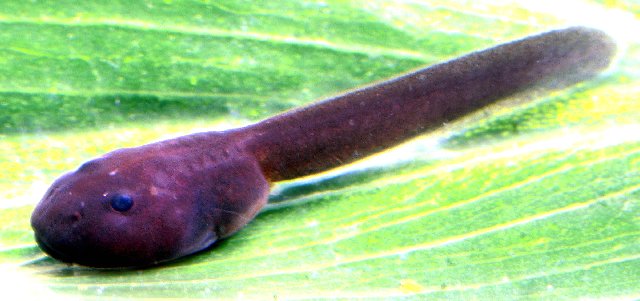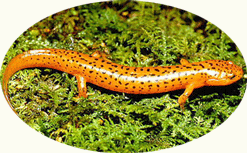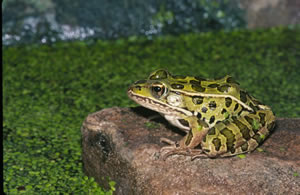- Home
- About S&T
- Taxa/Organisms
- Ecosystems
- Issues
- Methods & Tools
- Reports & Publications
- Location
- Search
Publisher: USGS | Science Center: Patuxent Wildlife Research Center (PWRC, Laurel) | Format: URL
www.pwrc.usgs.gov — The NAAMP is a collaborative effort among regional partners, such as state natural resource agencies and nonprofit organizations, and the U.S. Geological Survey (USGS) to monitor populations of vocal amphibians. The USGS provides central coordination and database management. The regional partners recruit and train volunteer observers to collect More...

Publisher: Center for Biological Informatics | Format: URL
www.frogweb.gov — FrogWeb is a multi-agency initiative that provides information about recent, global declines and deformities among amphibian populations, and efforts made by scientific agencies to study and address the phenomena.

Publisher: USGS | Science Center: Patuxent Wildlife Research Center (PWRC, Laurel) | Format: URL
www.pwrc.usgs.gov — This site is a tutorial and key for identifying tadpoles and frog larvae, examining morphological traits, and color photographs are included to simplify the identification process.

Publisher: USGS | Science Center: Patuxent Wildlife Research Center (PWRC, Laurel) | Format: URL
www.pwrc.usgs.gov — From the website: "This website provides a resource for learning breeding calls of frogs and toads in the eastern United States and Canada. This site provides links to a frog call lookup tool, public quizzes for identifying frog calls in states and provinces through amphibian monitoring programs such as Frogwatch USA, NAAMP, Parks/Refuges by More...

Publisher: USGS | Science Center: Patuxent Wildlife Research Center (PWRC, Laurel) | Format: URL
www.pwrc.usgs.gov — An overview of research that addresses the issue of amphibian decline, assesses relationships between amphibian distribution and abundance and environmental factors in the parks, proposes standardized, long-term monitoring protocols, and evaluates and validates amphibian monitoring techniques at Shenandoah and Big Bend National Parks. The project More...

Publisher: USGS | Science Center: Patuxent Wildlife Research Center (PWRC, Laurel) | Format: URL
igsaceeswb00.er.usgs.gov:8080 — From the Web site: "The Amphibian Research and Monitoring Initiative (ARMI) National Atlas for Amphibian Distributions (or simply, the ARMI Atlas), is a compilation of current and historic records of amphibian occurrences. These records are from published, peer-reviewed scientific literature, museum records, state and regional herpetological More...

Publisher: NBII | Format: URL
frogweb.nbii.gov — NARCAM is a website reporting system for malformed amphibian malformations. The site is a portal of archives for malformed amphibian phenomena reports in the United States and Canada. Users can submit a Report to NARCAM, view malformations data, with access to maps of malformation occurrences. You can also learn more about the UV radiation, More...

Publisher: Center for Biological Informatics | Format: URL
www.frogweb.gov — Amphibian population declines are particularly serious in California, the Rocky Mountains, the Southwest, and Puerto Rico. This website addresses this concern by linking to resources about Amphibian Declines, Amphibian malformations, and resources to what can be done to help. There are additional links to species information and resources for More...

Publisher: USGS | Science Center: Upper Midwest Environmental Sciences Center (UMESC, LaCrosse) | Format: URL
www.umesc.usgs.gov — Constructed farm ponds represent significant breeding, rearing, and overwintering habitat for amphibians in the Driftless Area Ecoregion of southeastern Minnesota, western Wisconsin, and northeastern Iowa, a landscape where natural wetlands are scarce. Farm ponds are to prevent soil erosion and create wildlife habitat, yet no studies have been More...

Publisher: USGS | Science Center: Forest and Rangeland Ecosystem Science Center (FRESC, Corvallis) | Format: URL
fresc.usgs.gov — There is a relatively rich herpetofauna in southwestern Oregon with about 38 species present. These species are almost equally divided between amphibians and reptiles. The objective of this issue overview is to conduct field surveys and assess status of several amphibian species of management concern, including: Western toad (Bufo boreas), Cascade More...

Publisher: USGS | Science Center: Western Ecological Research Center (WERC, Sacramento) | Format: URL
www.werc.usgs.gov — This site is a field guide to the reptiles and amphibians of coastal Southern California, including species accounts, illustrations of tadpoles, and images of different habitat types. The guide also contains a glossary of terms, a map of the study area, and types of habitats.

Publisher: USGS | Science Center: Forest and Rangeland Ecosystem Science Center (FRESC, Corvallis) | Format: URL
fresc.usgs.gov — An overview of research that defines the distribution and habitat requirements of amphibians and reptiles in southern Oregon, mostly in old-growth forests or alpine habitats. Includes links to USGS publications resulting from this research.
